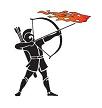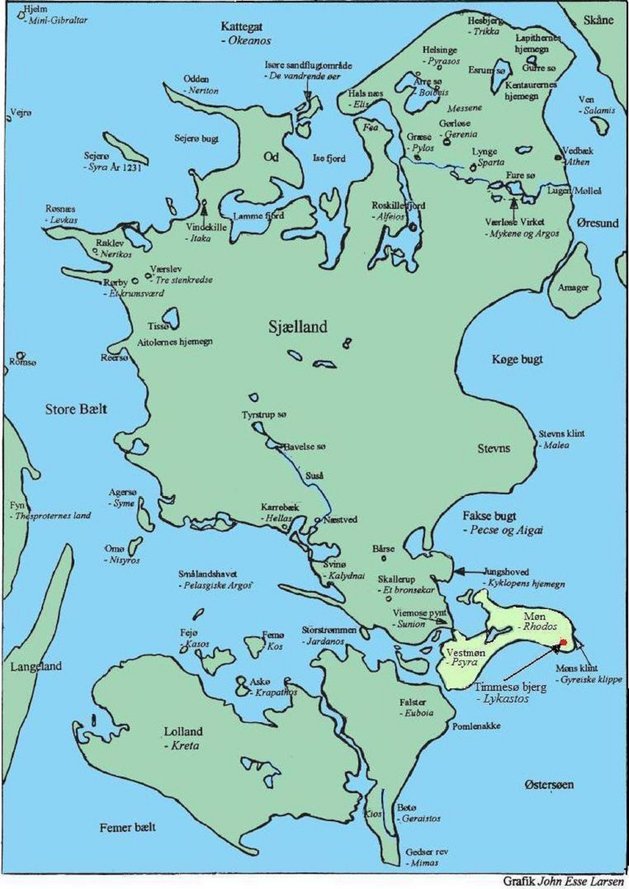
Odysseus
Isse from the island Od in Denmark
The Danaan islands
Seeland Lolland Falster and Møn
According to Homer in the Iliad, its people, cities and islands all together lie in the Greek archipelago – the Aegean. They do not lie in perfectly logical order when you follow chapter two in the Iliad's catalogue of ships.
There is a natural explanation to this.
All cities and Islands have their predecessor in the Danish archipelago and the coasts around. In the northern Aegean Sea – or the Belt Sea as it is also called.
According to one explanation the name Aegean originate from the sea god Poseidon's mythical homeland Aegae.
– He (Poseidon) took three paces – with the fourth he reached his goal,
– Aegae, where his famous palace had been built
– of eternal gold and marble deep within the sea (Il. 13-21).
A second and more logical explanation may be that the name Aegean is an Old Norse ey meaning island. Islands are called eyjar in Icelandic, which comes closest to Old Norse. The logic is then that Aegean means Islands, and the Aegean Sea means the archipelago.
So we have a southern Aegean Sea with the Greek Islands and coasts around the. We have a northern Aegean with the Danish Islands and coasts around.
With the help of the Odyssey, the Iliad, and our knowledge about the main people's actual homes, we can place most towns and islands properly on the Nordic map. Some locations in the Iliad fall into place all by itself.
Here's the location of the most significant towns and Islands in the Danaan area. Then follows a short description of the more hard to pinpoint Trojan areas.
The Danaans has 44 leaders, of whom ten die in the Iliad, and a total of 1186 ships carrying around 60,000 men over the Baltic Sea to Rügen and Pomerania.
Lamme fjord, Sidinge fjord
and Isøre sand drift region - the jagged islands
- are shown before building the dams

The location of Achaeans, Argives and the Danaan people and their islands are described on page 35-37 in the book Odysseus - Isse from the island Od which is available last under Documents and Links. 12 mb, 202 pages.
Here is a small excerpt.
(Il.2-557) From Salamis Ajax, the son of Telamon, commanded twelve ships. He organized his men in their positions, so they stood adjacent to Athenian ranks.
Salamis is the island Ven in the sound.
(Il.2-546) Soldiers under Menestheus came from that well-built fortress Athens. They had fifty black ships with them.
Athens is the small port Vedbæk in the Sound (Øresund).
(Il.2-559) Warriors from Argos, fortified Tiryns – and seven other cities – are led by Diomedes and two other commanders. These men brought with them eighty black ships.
Argos and Tiryns are likely the smaller eastern part of Værløse Virket in Hareskov by Fure Lake.
(Il.2-569) Troops from the strong fortress Mycenae – and ten other cities – are led by King Agamemnon and have one hundred ships with them.
Mycenae is likely the great western part of Værløse Virket at Lake Farum and Lake Fure.
The Boeotian town Aulis is located nearby Lake Fure. This is where a large part of the Danaan fleet is assembled:
– Not long ago, when our Achaean ships gathered at Aulis,
– bringing disaster for Priam and his Trojans (Il.2-303,496).
(Il.2-581) Men from Lacedaemon, land of ravines – and nine other cities – and the city of Sparta are led by Agamemnon's brother Menelaos. The Odyssey has the term to spacious Lacedaemon (Od.13-414). They have sixty ships.
Sparta is likely Lynge or Ganløse ore. Ganløse Ore and Sjöbo Ora in Skåne have both a Greek sounding surname 'ore'.
It is an Old Norse word meaning gravel hill. The Greek word oros means mountain.
(Il.2-591) Men from Pylos – and nine other cities – and the Geranian horseman Nestor led these men in a flotilla of ninety hollow ships.
Pylos is likely the town Græse near Frederikssund.
Two of the nine cities are Arene and Thryon (The small community Strø), that is often confused with Thryoessa.
– Now, there’s a certain city Thryoessa,
– far off on a steep hill by the Alfeius (Roskille Fjord,
– at the very end of sandy Pylos (Il. 11-711).
Thryoessa is the small town Strølille (Little Strø) on Strø Hill in Northern Seeland.
(Il. 2-631) Odysseus led on the Kefallenian soldiers from Ithaca, the well wooded ridge Neriton, and from Zakynthos and Samos. Also those inhabiting the mainland Seeland and those from cities on the facing shore. Odysseus, as wise as Zeus, led these troops, who came with him in twelve black ships.
The Odyssey and the Iliad mention Archamenides, Elpenor, Eurylochos, Macar, Mnestheos, Nisenos and Polites as Odysseus's men.
Ithaca is Od County, Zakynthos is Hindsholm Peninsula at Fyn (Funen) – it was formerly an island. Samos is the Northern Island on the two-piece island Samsø, and the Mainland is the nearby greater island Seeland just south of Vindekille. The facing shore is East Jutland opposite Od County.
Northern Samsø (Samos) has 20 square kilometer and Hindsholm (Zakynthos) has 50 square kilometer.